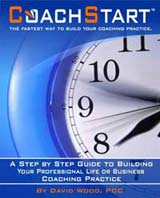Announcements/Offers
Make Your Own Coaching Career with the CoachStart™ Manual
 After years of hands-on research, including personally mentoring sixty coaches, I’ve compiled everything I know about starting a successful coaching practice in one easy-to-follow manual.
After years of hands-on research, including personally mentoring sixty coaches, I’ve compiled everything I know about starting a successful coaching practice in one easy-to-follow manual.
Learn how to set up your business and get clients
http://www.CoachStart.com
And I’m so excited to hear such great feedback:
“Let me start by saying I think this manual is fantastic. It is exactly what each person thinking about starting a coaching business needs to read! The biggest thing I got from this Manual was a new sense of confidence and competence. The simple exercises and role plays you’ve provided have made me eager to try some new methods.
– Daniel Midson Short www.lifestylerevolution.com.au
“David, I am really enjoying this Manual! It is clear, practical, comprehensive and inspirational, and it will be a great reference for me as I begin my coaching practice.”
-Carolyn Claiborne sacredgatherings@ earthlink.net
Visit http://www.CoachStart.com
Last Chance to Get Copyrighting Critique
Andy O’Bryan let me know he is retiring from copywriting for the coaching industry. This means you have only one more chance to have Andy look at your website and give you some valuable advice on how to bring in more clients.
He’s doing one final batch of complimentary website critiques, so book yours now:
http://www.andyobryan.com
So if you’re not bringing in enough clients with your website this is the perfect time to have Andy take a look. There’s no charge for this 30-minute one-on-one call, so get on his schedule at this link:
http://www.andyobryan.com
FEATURE: How to Give AND Grow Your Business
Taken from my book ‘Get Paid For Who You Are’

How to Give AND Grow Your Business
Typically, when people think of supporting a cause, they think of donating resources or volunteering time. Some companies let their staff spend half a day a week supporting any cause that they want on paid company time. That’s exciting. And it’s possible to go deeper. You can support a cause in a way that gets you more customers and revenue, by creating a two-way partnership, rather than a one-way relationship.
Ways You Can Help A Cause
1) Donate your product or service
The most basic way to support a cause is to donate your product or services. This product or service can be given to staff members, volunteers, beneficiaries, or even board members.
2) Offer your product or a service as a prize
You can offer your products or services as a prize for a sweepstakes or competition. In fact, why not reach out to 10 to 20 local nonprofit organizations in this way and start building relationships. For example, an accountant might donate 10 free tax returns to a charity raffle or auction.
3) Speak at their events
Is making public speaking appearances one of the things you can or will do? Many nonprofit organizations have conferences, training seminars and conventions. They need speakers to train, inspire, and entertain their members and donors. As Brendon Burchard says, “Who attends fundraisers – influential or non-influential people?” Speaking at fundraisers can put you in front of CEOs and other leaders who could hire you to speak, or buy your company’s product or service.
4) Give a percentage of profits
You could also donate a percentage of your annual profits to a cause. Again, try to do this as a partnership and create an agreement for what they will do in return. You may wish to tell them what your profits were last year and your projected earnings in the next year.
5) Invite your customers to donate
You could say to the nonprofit organization, “It’s not just what I’m going to be donating, but I’ll also be inviting my customers to donate.”
6) Microgiving call
Invite all your customers and newsletter subscribers to join on a conference call designed to raise money for charity. You might have a prominent member of the community or a local celebrity join you as co-host. Discuss an interesting topic, and every 10 minutes invite people to go to the website and donate. Of course, you can also do something like this in person and offer to host physical fundraisers.
How a Cause Can Support You
1) Website and Newsletter
A nonprofit organization can feature you on its website and describe their partnership with you, with a link to your website.
2) Press releases
They could issue press releases. You could tweak the same article that you wrote for their website, newsletter, or print magazine, into a press release for them to distribute. Who’s the media going to pay more attention to – a press release from you, or a press release from them?
3) Direct mail
They could give you exposure via direct mail. Suppose you are launching a CD and you’d like to use it as a fundraiser for them. They could put an ad for the CD in their electronic newsletter and on the home page of their website. And – they could mail out a little flier.
***
Take Action
1) Who would be a great fit for you to team with for a partnership? Share at the blog comments.
2) How large of a percentrage of sales would you share with your partnership? Share at the blog comments.


 After years of hands-on research, including personally mentoring sixty coaches, I’ve compiled everything I know about starting a successful coaching practice in one easy-to-follow manual.
After years of hands-on research, including personally mentoring sixty coaches, I’ve compiled everything I know about starting a successful coaching practice in one easy-to-follow manual.
